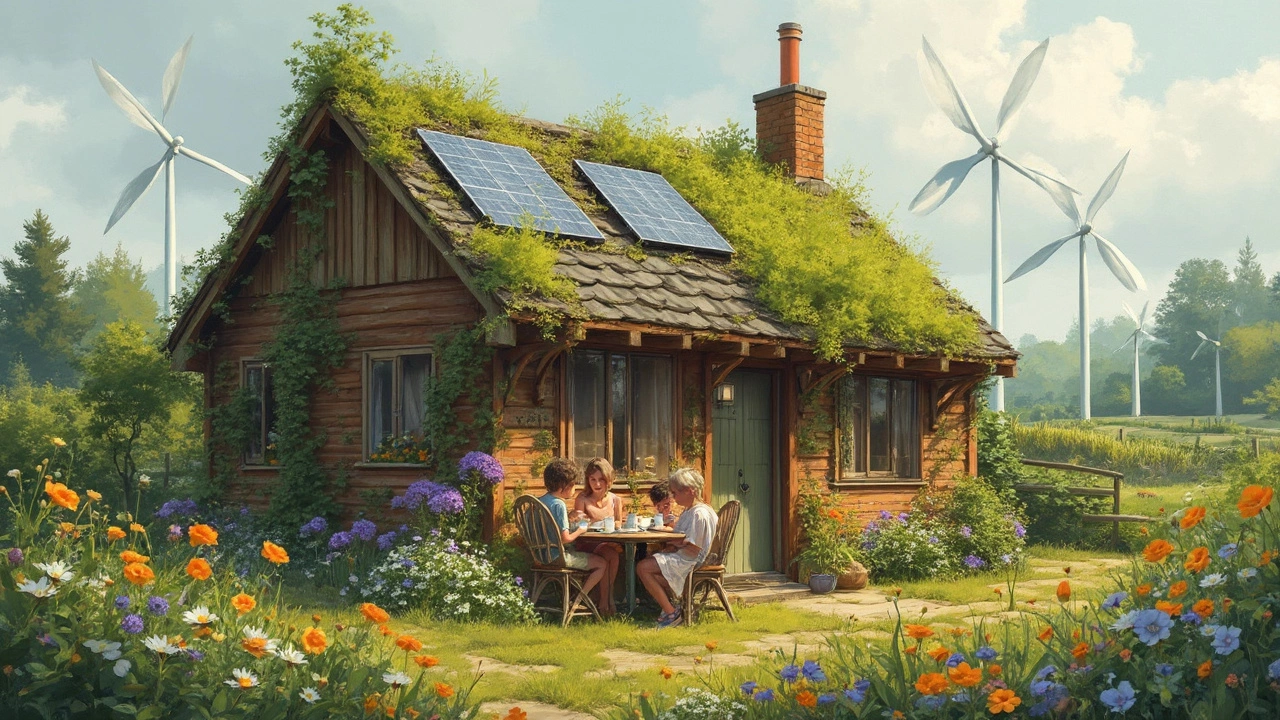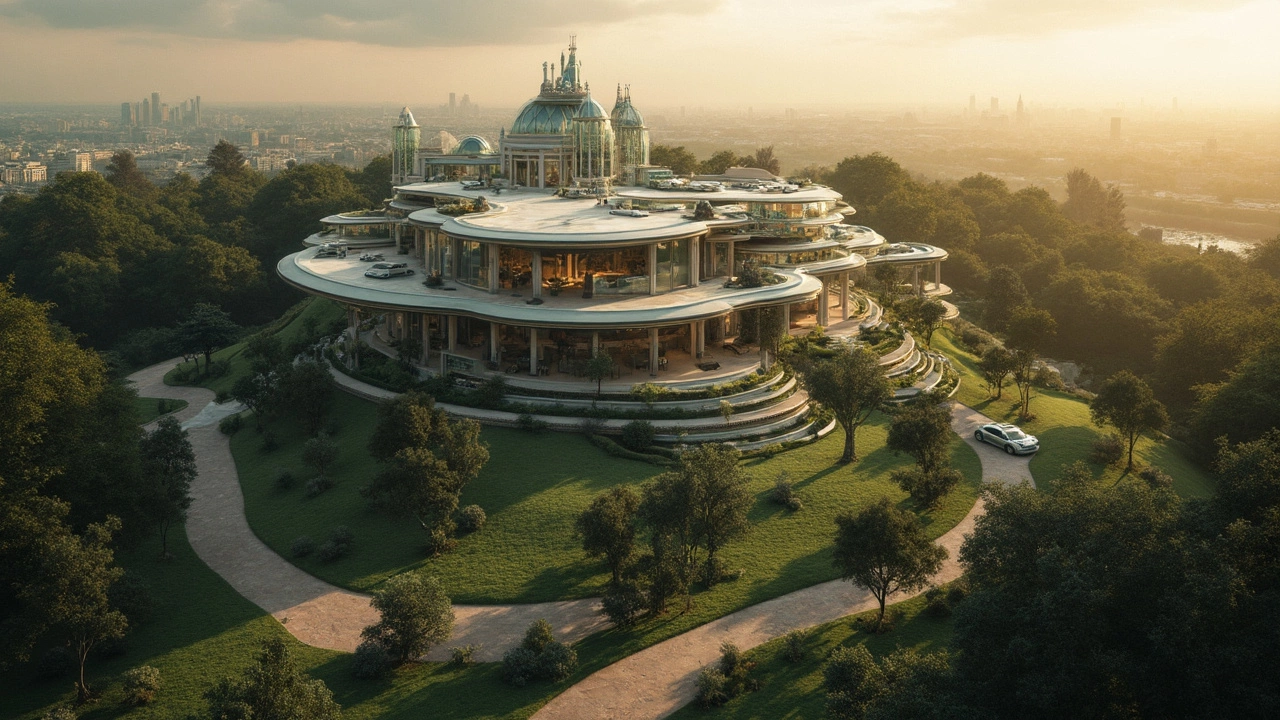You might think there’s some villain or movie star out there lounging in a $1 billion house, but finding an actual home with that sticker price is trickier than winning the lottery. The most expensive homes—like the infamous Antilia in Mumbai, which hovers around $2 billion—come loaded with stuff you probably don’t need: three helipads, a 168-car garage, spa floors, you get the idea. Sure, it's fun to look up, but none of this gets you closer to daily comfort or a smaller utility bill.
Now, what about eco-friendly cottages? Here’s the wild part: they focus on what actually matters—like smarter insulation, low-energy heating, and materials that don’t wreck the planet. Forget gold toilets; the must-have feature in 2025 is a rainwater collection system or solar panels that cut your electricity costs. Much less flashy, way more practical.
- What Does a Billion-Dollar Home Even Look Like?
- Why Green Cottages Don’t Cost a Fortune
- Tips for Building Eco-Friendly on Any Budget
- Real Value: Beyond the Price Tag
What Does a Billion-Dollar Home Even Look Like?
If you google the world’s priciest houses, you’ll run into some jaw-dropping numbers. The most famous contender is Antilia, sitting in the heart of Mumbai, India. That’s Mukesh Ambani’s skyscraper home—all 27 stories, with every detail stuffed with things most of us never even think about needing. Think three rooftop helipads, a six-floor car garage, and a whole floor just for hanging gardens. Over 600 staff take care of what’s basically a mansion disguised as an apartment tower. Latest estimates put its value at around $2 billion. Yeah, you read that right.
Other headline-stealers include Buckingham Palace, which gets valued at $4 to $6 billion. But it’s a working royal residence, not actually up for sale, so that price is more theoretical than real. In the U.S., the high end is “The One” in Bel Air, which listed for $295 million in 2022 after years of hype and construction headaches. A couple others—like Villa Leopolda in France—occasionally pop up in billionaire wish lists, but even those don’t flirt with $1 billion.
So, what do you actually find behind the gates of these homes? Here’s a quick look at what sets them apart:
- Size that’s off the charts (50,000+ square feet is normal)
- Lavish extras—nightclubs, bowling alleys, private theaters
- Custom art, rare antique finishes, walls lined with marble, gold, and crystal
- Extreme privacy measures (bulletproof glass, secret bunkers, over-the-top security)
You might be wondering how these prices stack up against regular homes—or even really nice billion dollar house listings. Here’s a table with a few major properties for perspective:
| Property | Location | Estimated Value | Main Features |
|---|---|---|---|
| Antilia | Mumbai, India | $2 Billion | 27-floors, helipads, home theater, ballroom, staff of 600+ |
| Buckingham Palace | London, UK | $4–6 Billion | 775 rooms, palace gardens, royal guards, historic value |
| The One | Los Angeles, USA | $295 Million (Listed Price) | 105,000 sq.ft., nightclub, 21 bedrooms, private movie theater |
| Villa Leopolda | French Riviera, France | $500–750 Million | 50 acres, historic gardens, Olympic pool |
Most billion-dollar houses reach their sky-high values thanks to custom architecture, insane locations, and mind-blowing extras—more than anything related to eco-friendly design. There’s nothing simple or green about these properties. In fact, their energy use could power a whole neighborhood. If you’re into sustainability, these are probably the last places you’d want to model after.
Why Green Cottages Don’t Cost a Fortune
People hear "eco-friendly cottage" and picture a pile of bills instead of a cozy getaway. That’s a myth. Building a green home doesn’t mean draining your savings. In fact, a bunch of studies show that building a green cottage costs just about 1% to 5% more up front than a regular build. Over a few years, though, you usually save that extra cash (and sometimes more) on energy, water, and maintenance bills.
Here’s what actually keeps costs in check with eco cottages:
- No need for fancy tech—simple stuff, like good windows or thick insulation, brings big results.
- Many governments offer tax breaks, grants, or rebates for green builds and energy upgrades. For example, the U.S. has offered tax credits up to 30% for solar panels.
- Building smaller: keeping your cottage footprint reasonable saves on materials and future energy use.
- Avoiding rare or luxury materials—bamboo, reclaimed wood, or recycled steel are both planet-friendly and often budget-friendly.
If you want stats, check out how costs compare:
| Feature | Initial Cost (Typical) | Annual Savings |
|---|---|---|
| Solar Panels | $10,000–$18,000 | $800–$1,200 |
| LED Lighting | $100–$200 (whole house) | $75–$200 |
| High-Performance Insulation | $2,000–$4,000 | $300–$500 |
Bottom line: you won’t find any eco-friendly cottages going for a billion bucks. They’re not loaded with gold faucets or rare marble floors. Instead, they save you money and lower your bills, all while being easier on the planet.

Tips for Building Eco-Friendly on Any Budget
Worried about green living being too pricey? Building or upgrading a cottage to be eco-friendly doesn’t mean you need billionaire cash. Smart, simple choices can save money upfront and long-term. Here’s what really makes a difference:
- Green homes start with better insulation. Use recycled denim or sustainable sheep’s wool batts in your walls and attic. This cuts heating and cooling costs, and you’ll notice the difference on bills every month.
- Switch to LED lights everywhere. It’s a cheap upgrade, and LEDs use up to 75% less energy and last 25 times longer than old bulbs. It’s boring but makes a real dent in energy costs.
- Use local or reclaimed building materials. Old barn wood, recycled bricks, and secondhand doors add character and keep trash out of landfills. Plus, they’re often cheaper than buying new.
- Install a programmable thermostat. For under $100, you’ll avoid wasting energy on heating or cooling an empty house. Set it once and forget it.
- Rainwater collection isn’t just for survivalists. A basic barrel setup can water your garden or lawn with zero extra cost after install. Some U.S. cities even offer rebates if you set one up.
- Solar panel prices have dropped more than 80% in the last decade. These days, you can start small—just enough to run a fridge or some lights—and add more as your budget allows.
- Seal up air leaks. Weatherstripping around windows and doors is super cheap and keeps drafts out. You’ll boost comfort fast without touching a loan.
The trick is picking a few upgrades, not trying to do everything at once. Focus on moves that hit energy costs first, because those savings pile up over time. Living sustainably isn’t just for people with billion-dollar budgets—it’s doable for just about anyone willing to plan and get hands-on.
Real Value: Beyond the Price Tag
When you look past jaw-dropping price tags and all the hype about billion-dollar homes, what actually makes a home valuable? Hint: it's not gold-plated bathtubs or robot butlers. These days, people care way more about how their house affects their wallet and well-being—like if it’s comfortable in any season and doesn’t make your utility bills explode.
The funny thing is, eco-friendly cottages keep showing up on the lists of the happiest homeowners worldwide. Why? Their value isn’t just about what you see; it’s how they perform day in and day out. For example, houses with great insulation and smart passive solar design can save owners up to 40% on yearly heating and cooling costs, according to the U.S. Department of Energy. That leaves you with more money to enjoy life instead of throwing it at bills.
Here’s a practical breakdown of what adds real value today:
- Energy efficiency: Homes with modern windows, high-grade insulation, and energy-saving appliances have better resale value.
- Low maintenance: Choose long-lasting, recycled materials—less patching up, less hassle.
- Health perks: Houses that use non-toxic paints and natural materials cut down on allergies and indoor air pollution.
- Utility costs: Cutting back on water and electricity isn’t just good for the planet; it’s awesome for your bank account.
Check out this quick table showing the difference in costs between a standard home and an eco-friendly cottage in 2024:
| Feature | Standard Home | Eco-Friendly Cottage |
|---|---|---|
| Average Annual Utility Bills | $2,650 | $1,500 |
| Resale Value Increase | 2-4% | 8-10% |
| Air Quality | Basic (may have VOCs) | High (low/no VOCs) |
When you stack up all these benefits, it’s pretty clear: the eco-friendly cottages might not come with butlers or a 100-car garage, but they deliver value that lasts—without blowing your budget or the planet. It’s smarter to invest in features you’ll use every day, instead of just bragging rights.
